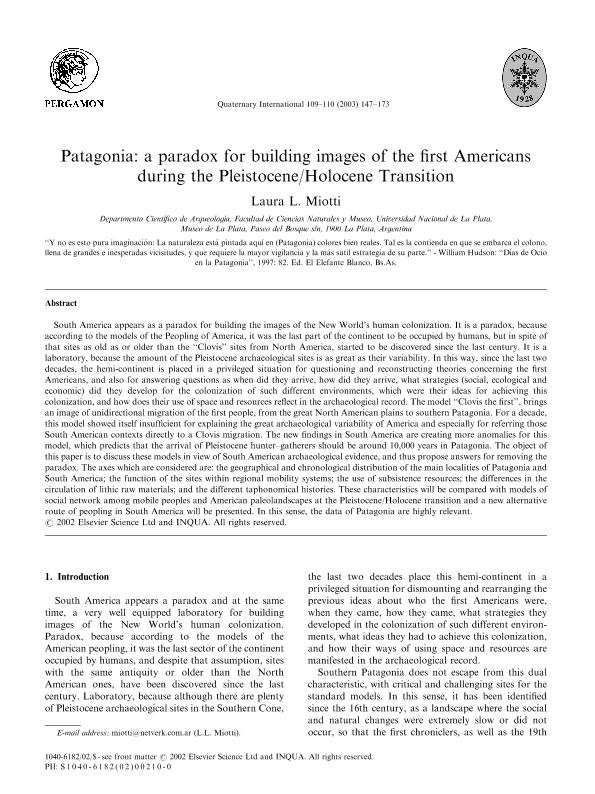Mostrar el registro sencillo del ítem
dc.contributor.author
Miotti, Laura Lucia

dc.date.available
2021-12-15T14:21:20Z
dc.date.issued
2003-12
dc.identifier.citation
Miotti, Laura Lucia; Patagonia: A paradox for building images of the first Americans during the Pleistocene/Holocene Transition; Pergamon-Elsevier Science Ltd; Quaternary International; 109-110; 12-2003; 147-173
dc.identifier.issn
1040-6182
dc.identifier.uri
http://hdl.handle.net/11336/148789
dc.description.abstract
South America appears as a paradox for building the images of the New World's human colonization. It is a paradox, because according to the models of the Peopling of America, it was the last part of the continent to be occupied by humans, but in spite of that sites as old as or older than the "Clovis" sites from North America, started to be discovered since the last century. It is a laboratory, because the amount of the Pleistocene archaeological sites is as great as their variability. In this way, since the last two decades, the hemi-continent is placed in a privileged situation for questioning and reconstructing theories concerning the first Americans, and also for answering questions as when did they arrive, how did they arrive, what strategies (social, ecological and economic) did they develop for the colonization of such different environments, which were their ideas for achieving this colonization, and how does their use of space and resources reflect in the archaeological record. The model "Clovis the first", brings an image of unidirectional migration of the first people, from the great North American plains to southern Patagonia. For a decade, this model showed itself insufficient for explaining the great archaeological variability of America and especially for referring those South American contexts directly to a Clovis migration. The new findings in South America are creating more anomalies for this model, which predicts that the arrival of Pleistocene hunter-gatherers should be around 10,000 years in Patagonia. The object of this paper is to discuss these models in view of South American archaeological evidence, and thus propose answers for removing the paradox. The axes which are considered are: the geographical and chronological distribution of the main localities of Patagonia and South America: the function of the sites within regional mobility systems; the use of subsistence resources; the differences in the circulation of lithic raw materials; and the different taphonomical histories. These characteristics will be compared with models of social network among mobile peoples and American paleolandscape at the Pleistocene/Holocene transition and a new alternative route of peopling in South America will be presented. In this sense, the data of Patagonia are highly relevant.
dc.format
application/pdf
dc.language.iso
eng
dc.publisher
Pergamon-Elsevier Science Ltd

dc.rights
info:eu-repo/semantics/openAccess
dc.rights.uri
https://creativecommons.org/licenses/by-nc-sa/2.5/ar/
dc.subject
PATAGONIA
dc.subject
PLEISTOCENE/HOLOCENE
dc.subject.classification
Arqueología

dc.subject.classification
Historia y Arqueología

dc.subject.classification
HUMANIDADES

dc.title
Patagonia: A paradox for building images of the first Americans during the Pleistocene/Holocene Transition
dc.type
info:eu-repo/semantics/article
dc.type
info:ar-repo/semantics/artículo
dc.type
info:eu-repo/semantics/publishedVersion
dc.date.updated
2021-12-03T19:35:20Z
dc.identifier.eissn
1873-4553
dc.journal.volume
109-110
dc.journal.pagination
147-173
dc.journal.pais
Estados Unidos

dc.description.fil
Fil: Miotti, Laura Lucia. Universidad Nacional de La Plata. Facultad de Ciencias Naturales y Museo. División Arqueología; Argentina. Consejo Nacional de Investigaciones Científicas y Técnicas. Centro Científico Tecnológico Conicet - La Plata; Argentina
dc.journal.title
Quaternary International
dc.relation.alternativeid
info:eu-repo/semantics/altIdentifier/url/https://www.sciencedirect.com/science/article/pii/S1040618202002100
dc.relation.alternativeid
info:eu-repo/semantics/altIdentifier/doi/https://doi.org/10.1016/S1040-6182(02)00210-0
Archivos asociados
